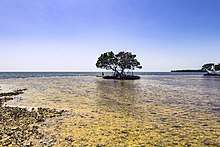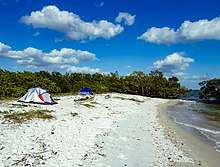Ten Thousand Islands
The Ten Thousand Islands are a chain of islands and mangrove islets off the coast of southwest Florida, between Cape Romano (at the south end of Marco Island) and the mouth of the Lostman's River. Some of the islands are high spots on a submergent coastline. Others were produced by mangroves growing on oyster bars.[1] Despite the name, the islets in the chain only number in the hundreds.
| Ten Thousand Islands National Wildlife Refuge | |
|---|---|
IUCN category IV (habitat/species management area) | |
 Ten Thousand Islands by U.S. Fish & Wildlife Service | |
 Ten Thousand Islands | |
| Location | Collier County, Monroe County, Florida, United States |
| Nearest city | Goodland, Florida |
| Coordinates | 25°51′N 81°30′W |
| Area | 35,000 acres (140 km2) |
| Established | 1996 |
| Governing body | U.S. Fish and Wildlife Service |
| www | |

Geography
The northern part of the Ten Thousand Islands, between Cape Romano and Everglades City, is in the Ten Thousand Islands National Wildlife Refuge.[2] The southern part of the Ten Thousands Islands, south of Everglades City, is in Everglades National Park.[3] The 99-mile long Wilderness Waterway begins at Everglades City and ends at Flamingo at the southern tip of the Florida peninsula.[4] Administrative control of the islands is split between Collier County and Monroe County.
Archaeology
The Ten Thousand Islands were used and occupied by Native Americans for thousands of years. Evidence of former living sites can be found under as much as four feet of water.[5] A number of shell rings and other shell complexes have been identified in or adjacent to the Ten Thousand Islands.[6] The Horr's Island archaeological site at the northern end of the Ten Thousand Islands was occupied year-round 3,500 years ago, and other sites are presumed to have been inundated by a rise in sea level.[7] The material culture of the Indians living in the Ten Thousand Islands was distinctive enough to be classified as, at least, a sub-area of the Glades culture area.[8]
Demography
Almost all of the Ten Thousand Islands are currently uninhabited. The largest, Chokoloskee Island, which is connected to Everglades City by a causeway, has about 400 permanent residents. Other islands have been sporadically inhabited in the 19th and 20th centuries by individuals or families.[9]
Recreation

Some of the Ten Thousand Islands are suitable for overnight visits, as dictated by the United States Fish and Wildlife Service. Since this is a wilderness area where wind, weather and lack of fresh water can become threatening, the Wildlife Service recommends only seasoned canoeists and sea kayakers attempt the trip.
Part of the archipelago lies within Everglades National Park. The following islands are officially designated camping sites:[10]
- Hog Key
- Turkey Key
- New Turkey Key
- Mormon Key
- Pavilion Key
- Rabbit Key
- Jewel Key
- Picnic Key
- Tiger Key
Dark skies recreation
Ten Thousand Islands archipelago is among the best and last remaining dark skies sites in coastal Southwest Florida. Most notable is Pavilion Key that lies 11 miles south of Everglades City and lacks any urban development to the south of it. The pristine nature and low south latitude makes the area among the best and unique spots for stargazing and Milky Way astrophotography.[11]
References
- Tebeau:29-30
- "Ten Thousand Islands National Wildlife Refuge". U.S. Fish and Wildlife Service. Retrieved 5 June 2011.
- "Ten Thousand Islands". National Park Service. Retrieved 5 June 2011.
- "Gulf Coast Trails". National Park Service. Retrieved 5 June 2011.
- Tebeau:29-30
- Schwadron, Margo (2010). "Landscapes of Maritime Complexity: Prehistoric Shell Works sites of the Ten Thousand Island, Florida". University of Leicester. Retrieved 8 December 2011.
- Milanich:85
- Milanich:277
- Tebeau:81-82
- in Wilderness Trip Planner
- in Dark Site Finder
- Milanich, Jerald T. (1994). Archaeology of Precolumbian Florida. Gainesville, Florida: University Press of Florida. ISBN 0-8130-1273-2.
- Tebeau, Charlton W. (1968). Man in the Everglades. Coral Gables, Florida: University of Miami Press.
![]()
External links
| Wikimedia Commons has media related to Ten Thousand Islands. |